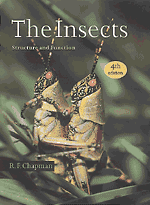Book contents
- Frontmatter
- Contents
- Preface
- Acknowledgments
- PART I The Head, Ingestion, Utilization and Distribution of Food
- PART II The Thorax and Locomotion
- PART III The Abdomen, Reproduction and Development
- PART IV The Integument, Gas Exchange and Homeostasis
- PART V Communication
- 20 Nervous system
- 21 Endocrine system
- 22 Vision
- 23 Mechanoreception
- 24 Chemoreception
- 25 Visual signals: color and light production
- 26 Mechanical communication: producing sound and substrate vibrations
- 27 Chemical communication: pheromones and chemicals with interspecific significance
- Taxonomic index
- Subject index
22 - Vision
Published online by Cambridge University Press: 05 June 2012
- Frontmatter
- Contents
- Preface
- Acknowledgments
- PART I The Head, Ingestion, Utilization and Distribution of Food
- PART II The Thorax and Locomotion
- PART III The Abdomen, Reproduction and Development
- PART IV The Integument, Gas Exchange and Homeostasis
- PART V Communication
- 20 Nervous system
- 21 Endocrine system
- 22 Vision
- 23 Mechanoreception
- 24 Chemoreception
- 25 Visual signals: color and light production
- 26 Mechanical communication: producing sound and substrate vibrations
- 27 Chemical communication: pheromones and chemicals with interspecific significance
- Taxonomic index
- Subject index
Summary
Light is perceived by insects through a number of different receptors. Most adult insects and larval hemimetabolous insects have a pair of compound eyes and often three single-lens eyes, called ocelli. Larval holometabolous insects have one or more single-lens eyes, known as stemmata, on the sides of the head. Some insects are also known to possess epidermal light receptors, and, in some cases, light is known to have a direct effect on cells in the brain.
COMPOUND EYES
Occurrence
Compound eyes are so called because they are constructed from many similar units called ommatidia. They are present in most adult pterygote insects and the larvae of hemimetabolous insects, but are strongly reduced or absent in wingless parasitic groups, such as the Phthiraptera and Siphonaptera, and in female coccids. This is also true of cave-dwelling forms. Amongst termites, compound eyes are greatly reduced or absent from stages that are habitually subterranean, and, although present in winged reproductives, the sensory components of the eyes may degenerate. Amongst Apterygota, compound eyes are lacking in some Thysanura, but Lepismatidae have 12 ommatidia on each side. Fullydeveloped compound eyes are present in Archaeognatha. In the non-insect orders of Hexapoda, Collembola have up to eight widely spaced ommatidia, while Protura and Diplura have none.
Each compound eye may be composed of several thousand ommatidia. There are about 10000 in the eyes of dragonflies and drone honeybees, 5500 in worker honeybees and 800 in Drosophila.
- Type
- Chapter
- Information
- The InsectsStructure and Function, pp. 585 - 609Publisher: Cambridge University PressPrint publication year: 1998



